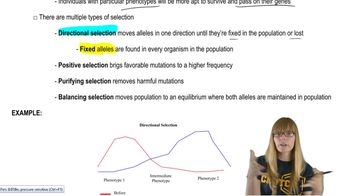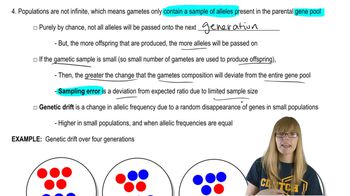Table of contents
- 1. Introduction to Genetics51m
- 2. Mendel's Laws of Inheritance3h 37m
- 3. Extensions to Mendelian Inheritance2h 41m
- 4. Genetic Mapping and Linkage2h 28m
- 5. Genetics of Bacteria and Viruses1h 21m
- 6. Chromosomal Variation1h 48m
- 7. DNA and Chromosome Structure56m
- 8. DNA Replication1h 10m
- 9. Mitosis and Meiosis1h 34m
- 10. Transcription1h 0m
- 11. Translation58m
- 12. Gene Regulation in Prokaryotes1h 19m
- 13. Gene Regulation in Eukaryotes44m
- 14. Genetic Control of Development44m
- 15. Genomes and Genomics1h 50m
- 16. Transposable Elements47m
- 17. Mutation, Repair, and Recombination1h 6m
- 18. Molecular Genetic Tools19m
- 19. Cancer Genetics29m
- 20. Quantitative Genetics1h 26m
- 21. Population Genetics50m
- 22. Evolutionary Genetics29m
21. Population Genetics
Allelic Frequency Changes
Problem 13b
Textbook Question
Two populations of deer, one of them large and living in a mainland forest and the other small and inhabiting a forest on an island, regularly exchange members that migrate across a land bridge that connects the island to the mainland. If you compared the allele frequencies in the two populations, what would you expect to find?
 Verified step by step guidance
Verified step by step guidance1
Understand the concept of gene flow: Gene flow is the transfer of genetic variation from one population to another. In this scenario, the migration of deer between the mainland and island populations represents gene flow.
Consider the effect of population size: The large mainland population is likely to have more genetic diversity compared to the smaller island population. This is because larger populations tend to have more alleles and less genetic drift.
Analyze the impact of migration: Regular migration between the two populations will lead to homogenization of allele frequencies. This means that over time, the allele frequencies in both populations will become more similar due to the exchange of individuals.
Predict the outcome: Due to gene flow, the allele frequencies in the island population will likely become more similar to those in the mainland population, especially if the migration rate is high relative to the size of the island population.
Consider the role of selection and drift: While gene flow tends to homogenize populations, natural selection and genetic drift can still cause differences in allele frequencies. However, if migration is frequent and substantial, gene flow will likely dominate these effects.
Recommended similar problem, with video answer:
 Verified Solution
Verified SolutionThis video solution was recommended by our tutors as helpful for the problem above
Video duration:
2mPlay a video:
Was this helpful?
Key Concepts
Here are the essential concepts you must grasp in order to answer the question correctly.
Allele Frequency
Allele frequency refers to how often a particular allele appears in a population compared to other alleles for the same gene. It is a key measure in population genetics, indicating genetic diversity and the potential for evolution. Changes in allele frequencies over time can signal evolutionary processes such as natural selection, genetic drift, or gene flow.
Recommended video:
Guided course

New Alleles and Migration
Gene Flow
Gene flow is the transfer of genetic material between populations through migration. In the context of the deer populations, the exchange of members across the land bridge allows for the mixing of alleles, which can lead to increased genetic diversity and potentially alter allele frequencies in both populations. This process can counteract the effects of genetic drift and local adaptation.
Recommended video:
Guided course

Mapping Genes
Population Structure
Population structure refers to the organization of a population in terms of genetic variation and the distribution of alleles. In this scenario, the mainland and island deer populations may exhibit different allele frequencies due to their distinct environments. However, regular migration between the two populations can lead to homogenization of allele frequencies, reducing differences over time.
Recommended video:
Guided course

Ribosome Structure

 5:58m
5:58mWatch next
Master Natural Selection with a bite sized video explanation from Kylia Goodner
Start learning



